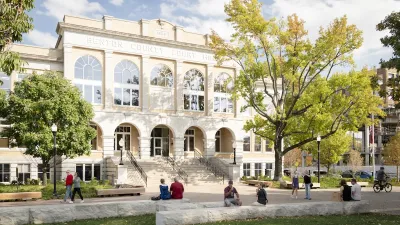A recent court ruling could turn the tide against a roadway expansion plan that threatens to displace homes and businesses and that locals say was pushed through with little transparency or community input.

A planned turnpike expansion project has prompted several lawsuits in Oklahoma, where local residents say the Oklahoma Turnpike Authority (OTA) acted without transparency when developing the proposal. Asia Mieleszko, writing in Strong Towns, describes the legal battle.
The saga began in 2021, when ODOT announced vague plans for a major long-range infrastructure plan. Then, “On February 22 [2022], the residents of Oklahoma, Cleveland, McClain, Osage, and Tulsa counties were formally, for the first time, introduced to the details of a $5 billion, 15-year turnpike expansion project whose trajectory seemed inevitable and whose route would devastate hundreds of homes, businesses, and natural areas.”
According to Mieleszko, “Named ACCESS Oklahoma, the plan involves widening four existing turnpikes, installing several new alignments, and constructing new access points for those alignments. Aspects of the project require expropriating businesses, homes, and farmland through eminent domain affecting five Oklahoma counties.”
The plaintiffs claim they weren’t given adequate notification about the project’s scope, with some finding out about the proposed route and the potential displacement of their homes or businesses through local newspapers. On December 1, 2022, a county judge “ruled that the OTA “willfully violated” the state’s Open Meetings Act, a decision supported by troubling evidence that emerged throughout the legal process.”
The most recent court ruling sets the project and OTA “back at square one,” with another Supreme Court case also challenging the legality of the venture.
FULL STORY: Ruling: Oklahoma Turnpike Authority “Willfully” Misled Public to Force $5 Billion Expansion Project

Alabama: Trump Terminates Settlements for Black Communities Harmed By Raw Sewage
Trump deemed the landmark civil rights agreement “illegal DEI and environmental justice policy.”

Study: Maui’s Plan to Convert Vacation Rentals to Long-Term Housing Could Cause Nearly $1 Billion Economic Loss
The plan would reduce visitor accommodation by 25% resulting in 1,900 jobs lost.

Why Should We Subsidize Public Transportation?
Many public transit agencies face financial stress due to rising costs, declining fare revenue, and declining subsidies. Transit advocates must provide a strong business case for increasing public transit funding.

Paris Bike Boom Leads to Steep Drop in Air Pollution
The French city’s air quality has improved dramatically in the past 20 years, coinciding with a growth in cycling.

Why Housing Costs More to Build in California Than in Texas
Hard costs like labor and materials combined with ‘soft’ costs such as permitting make building in the San Francisco Bay Area almost three times as costly as in Texas cities.

San Diego County Sees a Rise in Urban Coyotes
San Diego County experiences a rise in urban coyotes, as sightings become prevalent throughout its urban neighbourhoods and surrounding areas.
Urban Design for Planners 1: Software Tools
This six-course series explores essential urban design concepts using open source software and equips planners with the tools they need to participate fully in the urban design process.
Planning for Universal Design
Learn the tools for implementing Universal Design in planning regulations.
Smith Gee Studio
Alamo Area Metropolitan Planning Organization
City of Santa Clarita
Institute for Housing and Urban Development Studies (IHS)
City of Grandview
Harvard GSD Executive Education
Toledo-Lucas County Plan Commissions
Salt Lake City
NYU Wagner Graduate School of Public Service




























